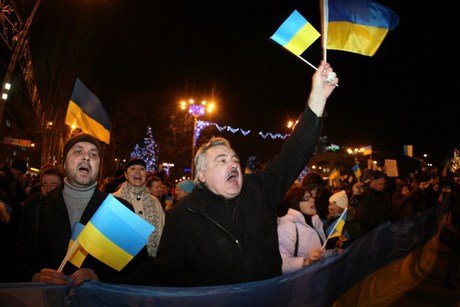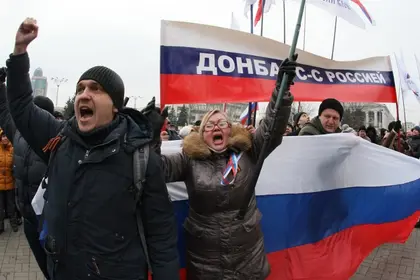It worked in some places.
After a few clashes with police and a number of smashed windows, Russian flags were raised over government administrations in Luhansk, Donetsk and Odesa on March 1-3.
JOIN US ON TELEGRAM
Follow our coverage of the war on the @Kyivpost_official.
Hundreds of pro-Russian activists also marched the streets of Kharkiv, Zaporizhzhia, Mykolayiv, demanding to organize referendums on federalization of Ukraine or even to attach these regions to Russia.
However, despite opposition to the EuroMaidan Revolution that topped Viktor Yanukovych as president on Feb. 22, the mostly Russian-speaking southeast didn’t rally en masse against Ukraine’s independence.
In fact, pro-Russian rallies in these cities were accompanied by rival demonstrations that featured slogans like “Putin Out!”
Andriy Parubiy, the National Security and Defense Council Secretary, said that residents of Ukraine’s densely populated southeast regions ruined the plans of Russian President Vladimir Putin to spread the Kremlin invasion beyond the Crimean peninsula.
“As residents of southern and eastern regions in their majority didn’t approve capture of their state meant that (Russian) blitzkrieg plan failed,” Parubiy said at a press briefing on March 5. Russian troops and military vehicles continued to assemble around Ukraine’s borders during the week, Ukrainian authorities said.

© AFP
By March 6, the Russian flag was taken off the Donetsk Oblast administration. The self-proclaimed governor of the region, Pavel Gubarev, who had seized the building three days earlying, was arrested along with 70 other separatists. His group held the administration building the longest of the three regions where similar takeovers had taken place.
In the meantime, a new poll released by Democratic Initiatives Foundation on March 3, showed that only a third of Donetsk region residents believe that they should be part of Russia.
IIn Luhansk and Odesa this number was lower still, at 24 percent.
Other supposedly pro-Russian regions — Zaporyhzhia, Kharkiv and Dnipropetrovsk — have 16, 15 and 13 percent of supporters of this idea, respectively.
At the same time, many residents of those areas think that the central authorities in Kyiv is remote and ineffective.
“The central government isn’t felt here in any way,” said Andriy Malchenko, 32, a businessman from Kherson. “Why aren’t they doing anything? Why are they allowing these chaps wave Russian flags in our city?”
Multiple eyewitness accounts, as well as Ukrainian officials, have claimed that separatist actions in southern and eastern Ukraine are fanned by Russia.
In some cases there were traveling groups of people who disguised themselves as locals. Photographs of the same women shouting pro-Russian slogans in Odesa and Kharkiv circulated in social networks. In one case. the women said they were Odesa natives, in another that they were Kharkiv natives. Similar groups of supporters were used during AntiMaidan demonstrations and were mocked as “traveling circuses.”
“There were Russian citizens. They even didn’t deny this fact,” said Oleksiy Matsuka, editor-in-chief of Novosti Donbassa, a leading Donetsk newspaper. Kyiv Post journalists in Kharkiv said they saw that pro-Russian activists also drive cars with Russian number plates.
Sergiy Taruta, the new billionaire governor of Donetsk Oblast, even appealed to those residents who live close to the border to stop dangerous extremists from crossing the border to Ukraine. “I’m sure there is a need to quickly close the border to prevent newcomers from taking subversive actions,” he told Novosti Donbassa on March 4. “I can’t call their actions anything else. Many of those people have guns.”
Valentyna Romanova, an expert on regional politics who works for a private think tank, said that the decision by Kyiv authorities to appoint as governors Taruta in Donetsk and Igor Kolomoisky in Dnipropetrovsk was one of the few positive steps taken by official Kyiv to kill separatism in its infacy. “The oligarchs are at least able to oppose provocateurs,” she said.
But appointment of the new governor of Luhansk Oblast is a different story. Mykhailo Bolotskyh, former head of State Service of Emergencies, has been heavily criticized by lawmakers Iryna Herashchenko and Anatoly Hrytsenko, who accused him of financing the AntiMaidan rallies. He has yet to comment on the accusations.
The rest of the governor positions in the regions have apparently been awarded on the basis of loyalty.
Valeriy Baranov, a former lawmaker with Volodymyr Lytvyn’s People’s Party, was appointed to goven over Zaporizhya Oblast.
New Kherson governor Yuriy Odarchenko is a former lawmaker of Batkivshchyna Party.
The new governor of Mykolayiv Oblast, Mykola Romanchuk, ran for parliament on Batkivshchyna’s Party list in 2012, but failed to get into the Rada.
New Odesa governor Volodymyr Nemyrovsky headed the local branch of Front Zmin, Arseniy Yatseniuk’s party that merged with Batkivshchyna.
Newly appointed Kharkiv governor Igor Baluta is a businessman close to Arsen Avakov, the interior minister.
Giving top jobs to friends is an old habit in Ukraine, and won’t help to build a new rule-of-law Ukraine demanded by the protesters who have been in the streets since November.
“The new authorities are making the same mistakes as the previous ones. They need to take into account what people think,” said Vladyslav Lukianov, a lawmaker of the now oppositional Party of Regions.
Kyiv Post staff writer Oksana Grytsenko can be reached at grytsenko@kyivpost.com. Kyiv Post staff writer Daryna Shevchenko contributed reporting to the story. She can be reached at shevchenko@kyivpost.com
You can also highlight the text and press Ctrl + Enter




